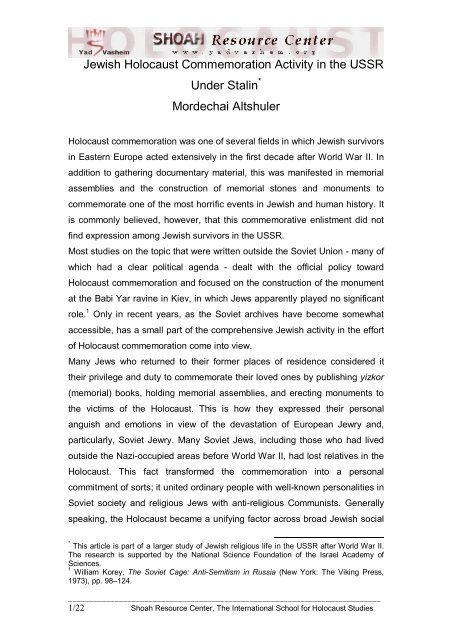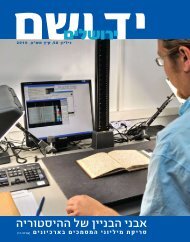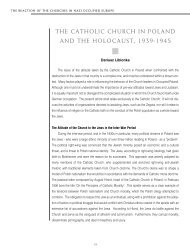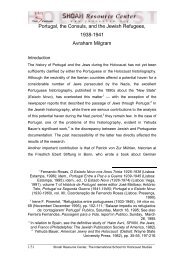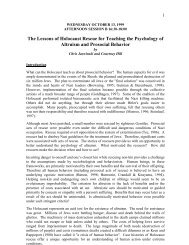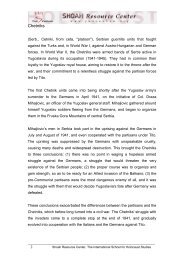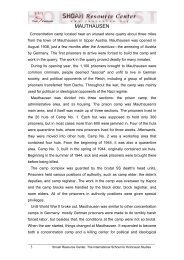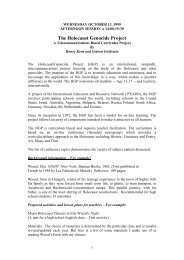Jewish Holocaust Commemoration Activity in the ... - Yad Vashem
Jewish Holocaust Commemoration Activity in the ... - Yad Vashem
Jewish Holocaust Commemoration Activity in the ... - Yad Vashem
Create successful ePaper yourself
Turn your PDF publications into a flip-book with our unique Google optimized e-Paper software.
<strong>Jewish</strong> <strong>Holocaust</strong> <strong>Commemoration</strong> <strong>Activity</strong> <strong>in</strong> <strong>the</strong> USSRUnder Stal<strong>in</strong> *Mordechai Altshuler<strong>Holocaust</strong> commemoration was one of several fields <strong>in</strong> which <strong>Jewish</strong> survivors<strong>in</strong> Eastern Europe acted extensively <strong>in</strong> <strong>the</strong> first decade after World War II. Inaddition to ga<strong>the</strong>r<strong>in</strong>g documentary material, this was manifested <strong>in</strong> memorialassemblies and <strong>the</strong> construction of memorial stones and monuments tocommemorate one of <strong>the</strong> most horrific events <strong>in</strong> <strong>Jewish</strong> and human history. Itis commonly believed, however, that this commemorative enlistment did notf<strong>in</strong>d expression among <strong>Jewish</strong> survivors <strong>in</strong> <strong>the</strong> USSR.Most studies on <strong>the</strong> topic that were written outside <strong>the</strong> Soviet Union - many ofwhich had a clear political agenda - dealt with <strong>the</strong> official policy toward<strong>Holocaust</strong> commemoration and focused on <strong>the</strong> construction of <strong>the</strong> monumentat <strong>the</strong> Babi Yar rav<strong>in</strong>e <strong>in</strong> Kiev, <strong>in</strong> which Jews apparently played no significantrole. 1 Only <strong>in</strong> recent years, as <strong>the</strong> Soviet archives have become somewhataccessible, has a small part of <strong>the</strong> comprehensive <strong>Jewish</strong> activity <strong>in</strong> <strong>the</strong> effortof <strong>Holocaust</strong> commemoration come <strong>in</strong>to view.Many Jews who returned to <strong>the</strong>ir former places of residence considered it<strong>the</strong>ir privilege and duty to commemorate <strong>the</strong>ir loved ones by publish<strong>in</strong>g yizkor(memorial) books, hold<strong>in</strong>g memorial assemblies, and erect<strong>in</strong>g monuments to<strong>the</strong> victims of <strong>the</strong> <strong>Holocaust</strong>. This is how <strong>the</strong>y expressed <strong>the</strong>ir personalanguish and emotions <strong>in</strong> view of <strong>the</strong> devastation of European Jewry and,particularly, Soviet Jewry. Many Soviet Jews, <strong>in</strong>clud<strong>in</strong>g those who had livedoutside <strong>the</strong> Nazi-occupied areas before World War II, had lost relatives <strong>in</strong> <strong>the</strong><strong>Holocaust</strong>. This fact transformed <strong>the</strong> commemoration <strong>in</strong>to a personalcommitment of sorts; it united ord<strong>in</strong>ary people with well-known personalities <strong>in</strong>Soviet society and religious Jews with anti-religious Communists. Generallyspeak<strong>in</strong>g, <strong>the</strong> <strong>Holocaust</strong> became a unify<strong>in</strong>g factor across broad <strong>Jewish</strong> social* This article is part of a larger study of <strong>Jewish</strong> religious life <strong>in</strong> <strong>the</strong> USSR after World War II.The research is supported by <strong>the</strong> National Science Foundation of <strong>the</strong> Israel Academy ofSciences.1 William Korey, The Soviet Cage: Anti-Semitism <strong>in</strong> Russia (New York: The Vik<strong>in</strong>g Press,1973), pp. 98–124.__________________________________________________________________________1/22Shoah Resource Center, The International School for <strong>Holocaust</strong> Studies
strata. Thus, it comes as no surprise that <strong>the</strong> <strong>in</strong>itiatives <strong>in</strong> <strong>Holocaust</strong>commemoration were taken at <strong>the</strong> local, grassroots level, while officialdom, for<strong>the</strong> most part, opposed or disapproved of this activity.Several Jews who had lost most of <strong>the</strong>ir families believed that <strong>the</strong> <strong>Jewish</strong> Anti-Fascist Committee should be <strong>in</strong> charge of commemorat<strong>in</strong>g <strong>Holocaust</strong> victims.In December 1945, General David Dragunskii expressed himself <strong>in</strong> this ve<strong>in</strong>:Where I was born [Novozibkov], 2 <strong>the</strong> German monsters shot all myrelatives - seventy-four members of <strong>the</strong> Dragunskii family…. The bonesof my sisters and <strong>the</strong> children lay sup<strong>in</strong>e <strong>in</strong> <strong>the</strong> field, where animals trodon <strong>the</strong>m…. The <strong>Jewish</strong> Anti-Fascist Committee must take action tobuild monuments [<strong>in</strong> <strong>the</strong> memory of] <strong>the</strong> children, <strong>the</strong> elderly, and <strong>the</strong>women who were shot…. It is difficult to forget this nightmare; <strong>the</strong> site[of <strong>the</strong> murders] should be fenced <strong>in</strong> and monuments with <strong>in</strong>scriptions<strong>in</strong>clud<strong>in</strong>g dates [of murder] should be stationed [<strong>the</strong>re]. 3Evidently, however, <strong>the</strong> <strong>Jewish</strong> Anti-Fascist Committee did not acceptDragunskii’s proposal to assume responsibility for <strong>the</strong> ceremonial and physicalcommemoration of <strong>the</strong> victims of <strong>the</strong> <strong>Holocaust</strong>. Thus, <strong>the</strong> kehillot (religiouscommunity organizations; s<strong>in</strong>gular, kehillah), <strong>the</strong> only legitimate agencies thatcont<strong>in</strong>ued to exist after <strong>the</strong> Anti-Fascist Committee was disbanded <strong>in</strong>November 1948, naturally became <strong>the</strong> ma<strong>in</strong> sponsors of <strong>the</strong> commemorative<strong>in</strong>itiatives. As <strong>the</strong> Nazi-occupied areas were successively liberated, suchkehillot had taken shape <strong>in</strong> most cities and towns that had <strong>Jewish</strong> population. 42 Novozibkov (Chernigov gubernia) had a <strong>Jewish</strong> population of 3,836 accord<strong>in</strong>g to <strong>the</strong> 1897census, one-fourth (25.4 percent) of <strong>the</strong> population at large. As <strong>the</strong> population of <strong>the</strong> towngrew, on <strong>the</strong> one hand, and as Jews migrated from it, on <strong>the</strong> o<strong>the</strong>r, <strong>the</strong> share of <strong>the</strong> <strong>Jewish</strong>population decl<strong>in</strong>ed. The January 1939 census found 3,129 Jews <strong>the</strong>re, only 13 percent of <strong>the</strong>population. Many of <strong>the</strong>m did not flee when Germany <strong>in</strong>vaded and rema<strong>in</strong>ed <strong>in</strong> Novozibkovunder Nazi occupation. The first Aktion <strong>the</strong>re, <strong>in</strong> which about 800 Jews were murdered, tookplace on February 17, 1942. Ilya Altman, ed., Neizvestnaia chernaia kniga (Jerusalem: <strong>Yad</strong><strong>Vashem</strong>, GARF: 1993), p. 402.3Genadii Kostyrchenko, ed., Evreiskii Antifashistskii Komitet v SSSR, 1941–1948,Dokumentorovanaia istoriia (Moscow: Mezhdunarodnye otnosheniia, 1996), p.108; ShimonRedlich, ed., War, <strong>Holocaust</strong> and Stal<strong>in</strong>ism: A Documented Study of <strong>the</strong> <strong>Jewish</strong> Anti-FascistCommittee <strong>in</strong> <strong>the</strong> USSR (Luxembourg: Harwood Academic Publishers, 1995), p. 231. I thankmy colleague, Professor Shimon Redlich, for call<strong>in</strong>g this document to my attention.4 Yaacov Ro’i, “The <strong>Jewish</strong> Religion <strong>in</strong> <strong>the</strong> Soviet Union after World War II,” <strong>in</strong> Yaacov Ro’i,ed., Jews and <strong>Jewish</strong> Life <strong>in</strong> Russia and <strong>the</strong> Soviet Union (Ilford: Frank Cass, 1995), pp. 264–289.__________________________________________________________________________2/22Shoah Resource Center, The International School for <strong>Holocaust</strong> Studies
The cause of commemorat<strong>in</strong>g <strong>the</strong> <strong>Holocaust</strong> became one of <strong>the</strong>ir focal po<strong>in</strong>tsof direct or <strong>in</strong>direct action. This activity on <strong>the</strong> part of <strong>the</strong> communities, or ofpeople directly or <strong>in</strong>directly associated with <strong>the</strong>m, overstepped <strong>the</strong> strictlyreligious doma<strong>in</strong> that <strong>the</strong> authorities had def<strong>in</strong>ed as <strong>the</strong> communities’responsibilities. Therefore, by donat<strong>in</strong>g funds, <strong>in</strong>vok<strong>in</strong>g personal connectionswith local officials, and so on, a very large number of Jews becameparticipants <strong>in</strong> <strong>Holocaust</strong> commemoration activity formally organized byostensibly religious communities. S<strong>in</strong>ce <strong>the</strong> communities were under <strong>the</strong>supervision of <strong>the</strong> Council for Religious Affairs by <strong>the</strong> Government of <strong>the</strong>Soviet Union (Sovet po Delam Religioznykh Kul’tov pri SNKSSSR; CARC)and its representatives <strong>in</strong> <strong>the</strong> oblasti (prov<strong>in</strong>ces), this activity is reflectedma<strong>in</strong>ly <strong>in</strong> <strong>the</strong> archival material of <strong>the</strong> CARC, which was <strong>in</strong>accessible until <strong>the</strong>past decade.Although <strong>the</strong> ma<strong>in</strong> and most extensive form of commemoration of <strong>Holocaust</strong>victims was physical, several attempts were made to publish victims’testimonies and writ<strong>in</strong>gs. In 1946, <strong>the</strong> L’viv (Lwów) 5 community began toga<strong>the</strong>r survivors’ testimonies and planned to publish this material <strong>in</strong> 1947. 6The V<strong>in</strong>nitsa community asked <strong>the</strong> municipality of that town for permission topublish a book with <strong>the</strong> names of <strong>Jewish</strong> townspeople whom <strong>the</strong> Nazis hadmurdered. On <strong>the</strong> marg<strong>in</strong>s of <strong>the</strong> application, <strong>the</strong> mayor, Petrov, wrote, “Themunicipality has no objection to <strong>the</strong> publication of a book about <strong>the</strong> victims ofFascism.” 7 However, no one followed up on <strong>the</strong> <strong>in</strong>itiatives of <strong>the</strong> kehillot <strong>in</strong>L’viv and V<strong>in</strong>nitsa; <strong>the</strong> activity focused ma<strong>in</strong>ly on <strong>the</strong> “Black Book” project that<strong>the</strong> <strong>Jewish</strong> Anti-Fascist Committee was prepar<strong>in</strong>g.Memorial Assemblies5 In this article we have made an exception to our editorial policy regard<strong>in</strong>g geographicnames. Ra<strong>the</strong>r than use <strong>the</strong> accepted name <strong>in</strong> 1938, or <strong>the</strong> name as it is most commonlyknown, we have for this article used <strong>the</strong> accepted names for <strong>the</strong> post-war period be<strong>in</strong>gdiscussed. [The editor]6 Report of Community Chairman Serebriannyi, January 5, 1947, Tsentralnyi GousdarstvennyiArkhiv Vysshykh Organov Vlasti i Upravleniia Ukra<strong>in</strong>y (TsGAVOU), Record Group (RG) 4648,List 2, File 33, pp. 138–139.7 Letter from <strong>the</strong> representative of <strong>the</strong> Council for Religious Affairs (CARC) <strong>in</strong> V<strong>in</strong>nitsa Oblastto <strong>the</strong> director of <strong>the</strong> oblast Agitprop Department about <strong>the</strong> latter’s misunderstand<strong>in</strong>g of Sovietpolicy on religious affairs s<strong>in</strong>ce 1948, Gosudarstvennyi Arkhiv V<strong>in</strong>itskoi Obladsti (GAVO), RGR-2700, List 19, File 35, p. 27.__________________________________________________________________________3/22Shoah Resource Center, The International School for <strong>Holocaust</strong> Studies
One of <strong>the</strong> first assemblies seems to have taken place <strong>in</strong> Khar’kov <strong>in</strong> January1945, mark<strong>in</strong>g <strong>the</strong> third anniversary of <strong>the</strong> horrific murder of <strong>the</strong> Jews <strong>in</strong> thattown. At <strong>the</strong> ga<strong>the</strong>r<strong>in</strong>g, <strong>the</strong> community raised some 15,000 rubles for <strong>the</strong>commemoration of <strong>Holocaust</strong> victims. 8 However, assemblies of this type wereoften opposed. In 1945–1946, <strong>the</strong> Novograd-Volynskiy community wanted toorganize memorial assembles at <strong>the</strong> place where <strong>the</strong> Jews of that town hadbeen murdered, but <strong>the</strong> authorities objected. 9 In August 1946, <strong>the</strong> Jews ofKamenets-Podol’skiy attempted to hold an assembly to mark <strong>the</strong> anniversaryof <strong>the</strong> murder of 23,000 Jews <strong>the</strong>re <strong>in</strong> 1941, but <strong>the</strong> mayor, Lemchuk, whoseems to have been antisemitic, forbade it categorically. 10The kehillah members, however, did not accept <strong>the</strong> ban. In July 1948, <strong>the</strong>ycompla<strong>in</strong>ed to <strong>the</strong> president of <strong>the</strong> Soviet Union (<strong>the</strong> chairman of <strong>the</strong> SupremeSoviet), Nikolai Shvernik, and <strong>the</strong> prime m<strong>in</strong>ister of <strong>the</strong> Ukra<strong>in</strong>e, NikitaKhrushchev:In 1946, we all presented <strong>the</strong> mayor with our request, which emanatedfrom <strong>the</strong> depths of <strong>the</strong> souls of hundreds of Jews, to allow us to mark<strong>the</strong> tragic day of bereavement, [<strong>the</strong> day] when our <strong>in</strong>nocent mo<strong>the</strong>rs,fa<strong>the</strong>rs, and children were tortured to death and murdered en masse,but he refused…. S<strong>in</strong>ce 1944, <strong>the</strong> kehillah <strong>in</strong> Kamenets-Podol’skiy hasbeen ask<strong>in</strong>g <strong>the</strong> mayor to allow us to arrange, modestly, <strong>the</strong> massgraves where our fa<strong>the</strong>rs and parents were buried, <strong>the</strong> places wheretens of thousands of our parents, bro<strong>the</strong>rs, sisters, and children wereburied alive, places where <strong>the</strong> ground trembled with fear and terror. Inano<strong>the</strong>r year, it will no longer be possible to recognize <strong>the</strong> place where,<strong>in</strong> 1941, <strong>the</strong> German murderers perpetrated a tragedy of <strong>the</strong> likes neverknown <strong>in</strong> human history. The pits are be<strong>in</strong>g covered over by thorns andgrass. The traces and memory of our dear sisters, mo<strong>the</strong>rs, andrelatives are slowly be<strong>in</strong>g obliterated, and despite our lawful demands,8 TsGAVOU, RG 4648, List 2, File 37, p. 38.9 Ibid., File 301, p. 77.10 Letter of grievance, Jews of Kamenets-Podol’skiy to President of <strong>the</strong> Ukra<strong>in</strong>e, September1947, ibid., File 37, p. 46.__________________________________________________________________________4/22Shoah Resource Center, The International School for <strong>Holocaust</strong> Studies
flow<strong>in</strong>g from hundreds of broken hearts and our sisters’ tears - ourrequest still rema<strong>in</strong>s unrequited. 11This impassioned request, like its precursors, was brushed aside. Theauthorities refused to lend official approval to a memorial assembly for victimsof <strong>the</strong> <strong>Holocaust</strong>, as <strong>the</strong>y had several years previously <strong>in</strong> Odessa.In Bogdanovka, about 150 km. from Odessa, tens of thousands of Jews weremurdered dur<strong>in</strong>g <strong>the</strong> German and Romanian occupation. The bodies werecremated to obliterate traces of <strong>the</strong> crime. This fact, confirmed by <strong>the</strong> SovietCommittee for Investigation of Nazi Crimes, was reported <strong>in</strong> a localnewspaper (Chernomorskaia Kommuna) on April 30, 1944. Thus, <strong>the</strong> Sovietsadmitted, <strong>in</strong> a sense, that <strong>the</strong> persons murdered were Jews and notunspecified Soviet citizens <strong>in</strong> general. 12 Pursuant to <strong>the</strong> report, D. V. Kl<strong>in</strong>ov, alead<strong>in</strong>g figure <strong>in</strong> <strong>the</strong> Odessa community, went to Bogdanovka, ga<strong>the</strong>red up<strong>the</strong> ashes and bones of <strong>the</strong> murdered Jews, contacted <strong>the</strong> CARCrepresentative on behalf of <strong>the</strong> community, and asked him to allow <strong>the</strong>community to conduct a public <strong>in</strong>terment of <strong>the</strong> rema<strong>in</strong>s on December 10,1946. He even <strong>in</strong>sisted that <strong>the</strong> assembly be advertised <strong>in</strong> <strong>the</strong> local press. TheCARC official, reluctant to make <strong>the</strong> decision, turned to his superiors <strong>in</strong> Kiev,who replied that such a public burial must never be allowed. “In Bogdanovka,”<strong>the</strong>y added, “citizens of various nationalities were cremated, not only Jews.Therefore, <strong>the</strong> appropriate <strong>in</strong>stitutions [sootvetstvuiushchie organy, i.e., <strong>the</strong>security services] should <strong>in</strong>vestigate to determ<strong>in</strong>e how <strong>the</strong> citizen D. V. Kl<strong>in</strong>ovcould have ga<strong>the</strong>red <strong>the</strong> ashes and bones of murdered persons <strong>in</strong>Bogdanovka and divided <strong>the</strong>m up by national criteria.” 13Thus, <strong>the</strong> authorities not only forbade a symbolic public burial for <strong>the</strong>se<strong>Holocaust</strong> victims but also suggested that such an attempt must have ulteriormotives that should be brought to <strong>the</strong> attention of <strong>the</strong> security services. By sobehav<strong>in</strong>g, <strong>the</strong>y correctly construed such actions as manifestations of national11 Letter of grievance, Jews of Kamenets-Podol’ski to President of <strong>the</strong> Ukra<strong>in</strong>e, September1947, ibid., File 37, p. 47, and ibid., File 52, p. 92. See also Tsentralnyi GosudarstvennyiArkhiv Obshchestvennykh Obed<strong>in</strong>enii Ukra<strong>in</strong>y (TsGAOOU), RG 1, List 70, File 1172, p. 5.12 See David Starodunskii, Odesskoe getto (Odessa: Khaitekh, 1991), pp. 14–15; Itzhak Arad,ed., Unichtozhenie evreev SSSR v gody nemetskoi okkupatsii (1941–1944), Sbornikdokumentov I materialov (Jerusalem: <strong>Yad</strong> <strong>Vashem</strong>, 1991), pp. 164–166.13 TsGAVOU, RG 4648, List 2, File 37, pp. 66–68.__________________________________________________________________________5/22Shoah Resource Center, The International School for <strong>Holocaust</strong> Studies
(or “nationalistic,” as <strong>the</strong>y put it) aspirations. In 1947, <strong>the</strong> CARC representative<strong>in</strong> <strong>the</strong> Ukra<strong>in</strong>e said as much <strong>in</strong> a memorandum about <strong>the</strong> <strong>Jewish</strong> religion:Nationalistic manifestations f<strong>in</strong>d special expression <strong>in</strong> <strong>the</strong> context of <strong>the</strong>mass graves where <strong>the</strong> patriots of our homeland, tortured to death by<strong>the</strong> German Fascists, are buried. Although it is well known that <strong>the</strong>segraves hold <strong>the</strong> rema<strong>in</strong>s of believers and nonbelievers and of membersof different nationalities, certa<strong>in</strong> <strong>Jewish</strong> public circles wish to transform<strong>the</strong>m <strong>in</strong>to <strong>the</strong> graves of murdered Jews. 14Although <strong>the</strong> authorities vehemently opposed outdoor memorial assembliesfor <strong>Holocaust</strong> victims, <strong>in</strong> <strong>the</strong> last phases of <strong>the</strong> war <strong>the</strong>y authorized and evenencouraged such assemblies <strong>in</strong> synagogues. To elevate <strong>the</strong> status of <strong>the</strong>rabbi of <strong>the</strong> Great Synagogue <strong>in</strong> Moscow, Shlomo Shlifer, and pursuant to anappeal by Chief Rabbi of Palest<strong>in</strong>e Isaac Herzog, <strong>the</strong> authorities agreed toallow a memorial service for <strong>Holocaust</strong> victims <strong>in</strong> <strong>the</strong> synagogue on March 14,1945. Participation was limited to ticket-holders, and <strong>the</strong> tickets weredistributed accord<strong>in</strong>g to official <strong>in</strong>structions. The recipients were governmentofficials, <strong>in</strong>clud<strong>in</strong>g Paul<strong>in</strong>a Zhemchuzh<strong>in</strong>a, <strong>the</strong> wife of Viacheslav Molotov,who sat <strong>in</strong> <strong>the</strong> men’s gallery. Also <strong>in</strong> attendance were high-rank<strong>in</strong>g officers,Yiddish writers (Itzik Fefer, Shmuel Halk<strong>in</strong>, David Hofshte<strong>in</strong>, Leyb Kvitko), 15and even Evgenii Tarle, an important Soviet historian of <strong>Jewish</strong> orig<strong>in</strong> whohad converted to Christianity <strong>in</strong> <strong>the</strong> n<strong>in</strong>eteenth century. Kaddish and El MalehRahamim were recited by Mikhail Aleksandrovich, a very popular s<strong>in</strong>ger <strong>in</strong> <strong>the</strong>USSR at <strong>the</strong> time. 16Memorial services also took place <strong>in</strong> additional locations. On August 12, 1945,<strong>the</strong> Mozir kehillah held a special memorial service for <strong>Holocaust</strong> victims. In14 Report on <strong>the</strong> state of <strong>the</strong> <strong>Jewish</strong> religion <strong>in</strong> <strong>the</strong> Ukra<strong>in</strong>e, July 1947: TsGAOOU, RG 1, List23, File 4556, p. 132.15 Although <strong>the</strong> Yiddish writers attended <strong>the</strong> memorial service with <strong>the</strong> authorities’ explicit ortacit approval, this “s<strong>in</strong>” was mentioned at <strong>the</strong> trial of <strong>the</strong> members of <strong>the</strong> <strong>Jewish</strong> Anti-FascistCommittee. Vladimir Naumov, ed., Nepravednyi sud- Poslednii Staliskii rasstrel (Moscow:Nauka), 1994, pp. 38, 115, 116;A somewhat abridged version appeared <strong>in</strong> English as: Stal<strong>in</strong>’sSecret Pogrom: The Post-War Inquisition of <strong>the</strong> <strong>Jewish</strong> Anti-Fascist Committee (New Haven:Yale University Press, 2001).16 Emanuel Mikhl<strong>in</strong>, The Ember (Hebrew) (Jerusalem: Shamir, 1986), pp. 94–96; MikhailAleksandrovich, Ia pomniu… (Moscow: n.p., 1992), pp. 138–140.__________________________________________________________________________6/22Shoah Resource Center, The International School for <strong>Holocaust</strong> Studies
advance of <strong>the</strong> event, <strong>in</strong>vitations were sent to about 500 prom<strong>in</strong>ent Jews andnon-Jews, <strong>in</strong>clud<strong>in</strong>g Fa<strong>the</strong>r Romanushko, a local Russian Orthodox priest. Of<strong>the</strong> 500 participants, 350 were young people and <strong>Jewish</strong> Communists 17 whoheld important positions <strong>in</strong> <strong>the</strong> town. The oblast radio station advertised <strong>the</strong>service. At this opportunity, 13,000 rubles were collected for <strong>the</strong> renovation of<strong>the</strong> synagogue and 4,000 rubles for <strong>the</strong> Soviet Red Cross. Remarks <strong>in</strong> praiseof <strong>the</strong> Red Army and Stal<strong>in</strong> were delivered at <strong>the</strong> service, and a special cablewas sent to <strong>the</strong> leader.In Belorussia, however, unlike <strong>in</strong> Moscow, <strong>the</strong> act of hold<strong>in</strong>g <strong>the</strong> memorialservice was fiercely criticized, and <strong>the</strong> local authorities were accused of“political myopia” (politicheskaia blizorukost‘). 18 In view of <strong>the</strong> vaguenesssurround<strong>in</strong>g hold<strong>in</strong>g memorial services for <strong>Holocaust</strong> victims <strong>in</strong> synagogues,<strong>the</strong> congregation of <strong>the</strong> Great Synagogue <strong>in</strong> Moscow sent <strong>the</strong> follow<strong>in</strong>g cableto most kehillot <strong>in</strong> December 1945 - with <strong>the</strong> authorities’ approval, of course:“The religious community of Moscow announces that religious Jews <strong>the</strong> worldover have designated a week of mourn<strong>in</strong>g start<strong>in</strong>g on March 8 <strong>in</strong> memory of<strong>the</strong> victims of <strong>the</strong> Fascist hangmen.” 19 Thus, many synagogues across <strong>the</strong>Soviet Union, <strong>in</strong>clud<strong>in</strong>g <strong>the</strong> Great Synagogue <strong>in</strong> Moscow, held memorialservices for <strong>Holocaust</strong> victims <strong>in</strong> 1946.In 1947, however, no special services for <strong>Holocaust</strong> victims seem to havebeen held <strong>in</strong> synagogues, although sometimes a general Yizkor memorialprayer was recited dur<strong>in</strong>g <strong>the</strong> hazkarat neshamot service.Why did <strong>the</strong> authorities feel differently about memorial assemblies for<strong>Holocaust</strong> victims held outdoors as opposed to ga<strong>the</strong>r<strong>in</strong>gs <strong>in</strong> synagogues?Two factors seem to expla<strong>in</strong> <strong>the</strong> difference. (1) The synagogue service mightbe construed as part of a religious activity that was permissible and legitimate<strong>in</strong> a house of worship but strictly forbidden outside; (2) <strong>the</strong> participants <strong>in</strong> <strong>the</strong>synagogue services were carefully selected and could be strictly monitored,17 Includ<strong>in</strong>g V<strong>in</strong>okur, director of <strong>the</strong> Human Resources Department of Poles’e Oblast, andGotlovskii, an editor for <strong>the</strong> oblast radio.18 Report of CARC representative <strong>in</strong> Poles’e Oblast for <strong>the</strong> third quarter of 1945; NatsionalnyiArkhiv Respubliki Belarus (NARB), RG 952, List 2, File 2, p. 84; report of CARCrepresentative <strong>in</strong> Poles’e Oblast for October 1, 1945–May 21, 1946, ibid., File 5s, pp. 15–17.19 Gosudarstvennyi Arkhiv Chernovitskoi Oblasti (GAChO), RG R–623, List 2, File 3, p. 6.__________________________________________________________________________7/22Shoah Resource Center, The International School for <strong>Holocaust</strong> Studies
as could <strong>the</strong> ceremony, which was scheduled and prepared <strong>in</strong> advance, unlikeoutdoor ceremonies at murder sites.Physical <strong>Commemoration</strong>The construction of monuments, unlike <strong>in</strong>dividual memorial assemblies andservices, was meant to create a permanent focal po<strong>in</strong>t of identification withvictims of <strong>the</strong> <strong>Holocaust</strong>. Therefore, it comes as no surprise that <strong>the</strong>authorities were especially sensitive about this activity, which actually beganbefore <strong>the</strong> end of <strong>the</strong> war. Indeed, <strong>the</strong> very idea of build<strong>in</strong>g a monument to <strong>the</strong>Warsaw ghetto fighters was actually conceived <strong>in</strong> <strong>the</strong> USSR <strong>in</strong> 1943. 20S<strong>in</strong>ce <strong>the</strong> murder of Jews across <strong>the</strong> USSR took place near each city andtown, 21 commemorative activities were not restricted to several centrallocations but were undertaken <strong>in</strong> many localities, of which only a few areknown thus far.Soviet authorities <strong>in</strong> <strong>the</strong> Baltic countries were often more favorably disposedto <strong>Holocaust</strong> commemoration than <strong>the</strong>ir counterparts elsewhere <strong>in</strong> <strong>the</strong>USSR. 22 This is evident with regard to <strong>the</strong> build<strong>in</strong>g of a monument to <strong>the</strong><strong>Holocaust</strong> victims <strong>in</strong> Vilna. In late 1946, <strong>the</strong> Vilna kehillah asked <strong>the</strong> CARCrepresentative <strong>in</strong> Lithuania for permission to put <strong>the</strong> mass graves <strong>in</strong> Ponary <strong>in</strong>appropriate order and to erect a monument <strong>the</strong>re. Dur<strong>in</strong>g <strong>the</strong> Nazi occupation,Ponary, about 10 kilometers from Vilna, had served as a kill<strong>in</strong>g ground fortens of thousands of Jews, Soviet prisoners of war, and anti-Nazi civilians.After <strong>the</strong> liberation, <strong>the</strong> place was neglected and left totally unmarked. TheCARC representative <strong>in</strong> Lithuania forwarded <strong>the</strong> request to <strong>the</strong> deputy primem<strong>in</strong>ister. He recommended that he reply <strong>in</strong> <strong>the</strong> affirmative and view favorably<strong>the</strong> proposal to put a monument on <strong>the</strong> site - <strong>in</strong> coord<strong>in</strong>ation with <strong>the</strong> chiefarchitect of <strong>the</strong> Lithuanian SSR, of course. 23 Follow<strong>in</strong>g this, memorial stoneswere also placed <strong>in</strong> o<strong>the</strong>r towns <strong>in</strong> <strong>the</strong> Lithuanian SSR where Jews had been20 Nathan Rapoport, “Memoir of <strong>the</strong> Warsaw Ghetto Monument,” James E. Young, ed., TheArt of Memory: <strong>Holocaust</strong> Memorials <strong>in</strong> History (Munich: Prestel, 1994), p. 106.21 See my article, “The Unique Features of <strong>the</strong> <strong>Holocaust</strong> <strong>in</strong> <strong>the</strong> Soviet Union,” <strong>in</strong> Ro’i, ed.,Jews and <strong>Jewish</strong> Life, pp. 171–211.22 The reasons for this still await thorough and systematic research beyond <strong>the</strong> purview of thisarticle. For several examples, see Zvi Gitelman, “The Soviet Politics of <strong>the</strong> <strong>Holocaust</strong>,” <strong>in</strong>Young, ed., The Art of Memory, p. 141.23 Letter from CARC representative <strong>in</strong> Lithuania (Push<strong>in</strong>is) to Deputy Prime M<strong>in</strong>ister ofLithuania (Naionkanai), March 12, 1948, LCVA, RG 12181, List 1, File 26, p. 77.__________________________________________________________________________8/22Shoah Resource Center, The International School for <strong>Holocaust</strong> Studies
murdered <strong>in</strong> <strong>the</strong> <strong>Holocaust</strong>, such as Seta and Utian, and <strong>in</strong> <strong>the</strong> town of Dobele<strong>in</strong> Latvia. 24In neighbor<strong>in</strong>g Belorussia, too, 25 <strong>the</strong>re were several attempts to commemorate<strong>Holocaust</strong> victims by means of monuments. In M<strong>in</strong>sk, fundrais<strong>in</strong>g for thispurpose was conducted, and <strong>the</strong> monument was built as <strong>the</strong> result of <strong>the</strong>close cooperation between <strong>the</strong> kehillah and Jews who held importantpositions <strong>in</strong> <strong>the</strong> adm<strong>in</strong>istrative and economic life of <strong>the</strong> town. 26 After <strong>the</strong>monument, with its <strong>in</strong>scriptions <strong>in</strong> Russian and Yiddish, was <strong>in</strong>stalled, <strong>the</strong>kehillah asked <strong>the</strong> authorities for permission to conduct an unveil<strong>in</strong>g ceremony<strong>in</strong> August 1946. They were refused on <strong>the</strong> grounds that, as a religious agency,<strong>the</strong> community had no right to act on behalf of <strong>the</strong> non-Jews and <strong>the</strong> nonreligiousJews who had been murdered <strong>the</strong>re. The community held <strong>the</strong> massunveil<strong>in</strong>g ceremony anyway. 27Pursuant to <strong>the</strong> commemoration activity <strong>in</strong> M<strong>in</strong>sk, a similar activity <strong>in</strong>Cherven, <strong>in</strong> <strong>the</strong> M<strong>in</strong>sk Oblast, began <strong>in</strong> November-December 1945. On <strong>the</strong>eve of World War II, Cherven had had a <strong>Jewish</strong> population of 1,491. Most of<strong>the</strong>m were murdered by <strong>the</strong> Nazis. After <strong>the</strong> Red Army liberated Cherven <strong>in</strong>early July 1944, dozens of <strong>Jewish</strong> families returned to <strong>the</strong> town, and several of<strong>the</strong>m organized a m<strong>in</strong>yan (prayer quorum). They even had a rabbi. The24 Gitelman, “The Soviet Politics,” p. 144–145; idem, A Century of Ambivalence (New York:Schocken, 1988), p. 185.25 A book recently published <strong>in</strong> Belarus mentions several localities where monuments andmemorial plaques were put up dur<strong>in</strong>g <strong>the</strong> period discussed <strong>in</strong> this article. Memorial markerswere erected <strong>in</strong> <strong>the</strong> cities of Borisov and Brest; <strong>the</strong> urban localities of Diatlovo,Radoshkovichi, Starob<strong>in</strong>, Uzda; and <strong>the</strong> villages of Lugovaia, Timkovichi, Budelav, Uzliany,Shatsk, Chernavchitsy, and Derech<strong>in</strong>. Accord<strong>in</strong>g to <strong>the</strong> author of <strong>the</strong> book, <strong>the</strong> monumentsand memorial plaques were placed <strong>in</strong> locations where Jews had been murdered; however,his sources and <strong>the</strong> contexts <strong>in</strong> which he relates <strong>the</strong>ir story do not make this clear.Fur<strong>the</strong>rmore, nowhere is it stated that <strong>the</strong>se markers were established at <strong>the</strong> Jews’ <strong>in</strong>itiative.Marat Botv<strong>in</strong>nik, Pamiatniki genotsida evreev Belarusi (M<strong>in</strong>sk: Belaruskaia navuka, 2000), pp.32–36, 43, 48, 55, 60–61, 68–69, 72–74, 77, 79, 81, 87, 89, 91–93, 96, 98, 111, 113, 117–118, 120, 135–136, 252, 257, 259, 271–272.26 Report from CARC representative <strong>in</strong> Belorussia for <strong>the</strong> third quarter of 1946, NARB, RG952, List 2, File 6, p. 41. See also Shalom Cholawski, In <strong>the</strong> Eye of <strong>the</strong> Hurricane: The Jews<strong>in</strong> Eastern Belorussia dur<strong>in</strong>g World War II (Jerusalem, Tel Aviv The Hebrew University ofJerusalem, The Institute for Contemporary Jewry, Sifriat Poalim and Moreshet, 1988)(Hebrew), p. 248. The director of <strong>the</strong> municipal physical-plant department (Nahum Gon<strong>in</strong>), <strong>the</strong>director of <strong>the</strong> Town Beautification Department (Yosef Nisenbaum), and <strong>the</strong> plant managerwho served <strong>in</strong> this department (Matvey Falkovich) assisted <strong>in</strong> build<strong>in</strong>g <strong>the</strong> monument. SeeLeonid Smilovitskii, Istoriia Evreev Belorusii, 1941–1944 (Tel Aviv: privately published, 2000),p. 280.27 Report from CARC representative <strong>in</strong> Belorussia for <strong>the</strong> third quarter of 1946, NARB, RG952, List 2, File 6, p. 41.__________________________________________________________________________9/22Shoah Resource Center, The International School for <strong>Holocaust</strong> Studies
members of this m<strong>in</strong>yan wanted to erect a monument to <strong>the</strong> Jews who hadbeen murdered dur<strong>in</strong>g <strong>the</strong> occupation. They also wanted to <strong>in</strong>scribe <strong>the</strong>names and ages of all <strong>the</strong> victims on <strong>the</strong> monument, <strong>in</strong> <strong>the</strong> sense of “To EveryPerson There Is a Name.” For this reason <strong>the</strong>y contacted Jews all overBelorussia and even <strong>in</strong> Moscow who had lived <strong>in</strong> Cherven <strong>in</strong> order to obta<strong>in</strong><strong>in</strong>formation about <strong>the</strong>ir relatives who had perished <strong>in</strong> <strong>the</strong> <strong>Holocaust</strong>. VladimirFundator, a scientist from Moscow whose parents had been murdered <strong>in</strong>Cherven, participated <strong>in</strong> this endeavor. Those wish<strong>in</strong>g to commemorate <strong>the</strong>irloved ones by <strong>in</strong>scrib<strong>in</strong>g <strong>the</strong>ir names on <strong>the</strong> monument were asked to donateat least 300 rubles. In all, some 15,000 rubles were collected. The money wasused to order forty metal plaques from a foundry <strong>in</strong> Moscow and to <strong>in</strong>scribe on<strong>the</strong>m <strong>the</strong> names of <strong>the</strong> <strong>Holocaust</strong> victims from Cherven. The plan was torecord about twenty-five names on each plaque, or about 1,000 <strong>in</strong> all. As <strong>the</strong>monument was be<strong>in</strong>g prepared, <strong>the</strong> organizers ran <strong>in</strong>to f<strong>in</strong>ancial difficultiesand were unable to complete <strong>the</strong> work. 28 Thus, on September 14, 1946,Vladimir Fundator wrote to <strong>the</strong> head of <strong>the</strong> <strong>Jewish</strong> Anti-Fascist Committee,Shlomo Mikhoels:I send you a photograph of <strong>the</strong> first plaque that will be stationed on <strong>the</strong>grave of <strong>the</strong> victims of Fascism <strong>in</strong> Cherven.... Forty such plaques willbe cast. I ask you to persuade <strong>the</strong> Belorussian Council of M<strong>in</strong>isters toallocate 30,000 rubles for <strong>the</strong> construction of a monument at <strong>the</strong> graveof <strong>the</strong> victims of Fascism <strong>in</strong> Cherven, <strong>in</strong> addition to <strong>the</strong> 15,000 rublesthat we have collected for <strong>the</strong> manufacture of <strong>the</strong> aforementionedplaques <strong>in</strong> Moscow. Several people have suggested that we <strong>in</strong>stall <strong>the</strong>plaques on a wall of a stone build<strong>in</strong>g <strong>in</strong> Cherven itself and affix oneplaque with a general <strong>in</strong>scription at <strong>the</strong> site of <strong>the</strong> grave of <strong>the</strong> victimsof Fascism. Please let us know your op<strong>in</strong>ion. 2928 Leonid.Smilovitskii, “Eto bylo v Chervene,” <strong>in</strong> Evrei Belarusi; Istoriia I kultura (M<strong>in</strong>sk:Belorusskoe ob”ed<strong>in</strong>enie evreiskikh organizatsii I obshch<strong>in</strong>, 1998), vol. III-IV, pp. 223–231.29 Central Archive of <strong>the</strong> <strong>Jewish</strong> People, P–199. See also Mordechai Altshuler, “The <strong>Jewish</strong>Antifascist Committee <strong>in</strong> <strong>the</strong> USSR <strong>in</strong> Light of New Documentation,” Studies <strong>in</strong> ContemporaryJewry, vol. 1 (1984), pp. 280–281.__________________________________________________________________________10/22Shoah Resource Center, The International School for <strong>Holocaust</strong> Studies
Thus, by late 1946, <strong>the</strong> sponsors of this monument project had not yetcompleted it. They met with fundrais<strong>in</strong>g difficulties and had to requestassistance from <strong>the</strong> Belorussian authorities. We do not know if ShlomoMikhoels actually contacted <strong>the</strong> Government of Belorussia <strong>in</strong> this matter. If hedid so, <strong>the</strong> government probably would have turned down his request anyway,due to its dim view of <strong>Holocaust</strong> commemoration <strong>in</strong> general. The affair,however, is evidence of extensive <strong>Jewish</strong> activity <strong>in</strong> <strong>the</strong> commemoration of<strong>Holocaust</strong> victims. Jews from various towns participated <strong>in</strong> <strong>the</strong>se efforts, andreligious circles and prom<strong>in</strong>ent figures <strong>in</strong> <strong>the</strong> Soviet establishment ma<strong>in</strong>ta<strong>in</strong>edcooperative relations <strong>in</strong> <strong>the</strong>ir jo<strong>in</strong>t endeavors.In Rechitsa, <strong>in</strong> <strong>the</strong> Gomel Oblast, <strong>the</strong>re had been more than 7,000 Jewsbefore <strong>the</strong> war, one-fourth of <strong>the</strong> local population. Only several dozen <strong>Jewish</strong>families returned after <strong>the</strong> liberation, and a monument of bricks for <strong>the</strong><strong>Holocaust</strong> victims was built <strong>in</strong> <strong>the</strong> <strong>Jewish</strong> cemetery <strong>in</strong> 1946. 30 The few Jewswho returned to <strong>the</strong> town of Glubokoe, also <strong>in</strong> <strong>the</strong> Gomel Oblast, alsomanaged to erect a monument at <strong>the</strong> grave of <strong>the</strong> <strong>Holocaust</strong> victims, with an<strong>in</strong>scription <strong>in</strong> Yiddish. 31At that time efforts were be<strong>in</strong>g made to set up monuments for <strong>Holocaust</strong>victims <strong>in</strong> at least fifteen cities and towns <strong>in</strong> <strong>the</strong> Ukra<strong>in</strong>e, <strong>in</strong>clud<strong>in</strong>g four cities <strong>in</strong>areas that <strong>the</strong> Soviet Union had annexed dur<strong>in</strong>g World War II (L’viv,Kamenets-Podol’skiy, and Chernevtsy Oblasti).In early 1947, <strong>the</strong> head of <strong>the</strong> L’viv community, Lev Izrailovich Serebriannyi,proposed “to set up a massive monument <strong>in</strong> ‘Piaski,’ where <strong>the</strong> Hitlerists shottens of thousands of Jews from L’viv.” 32 The general assembly of <strong>the</strong> kehillahadopted a resolution to this effect: “<strong>in</strong> 1947 ... to build a monument on <strong>the</strong>common grave of <strong>the</strong> victims of Fascism who are buried <strong>in</strong> ‘Piaski’.” 33However, <strong>the</strong> resolution seems not to have been implemented, because aboutthree weeks later (on March 25), <strong>the</strong> chairman of <strong>the</strong> community was arrested30 Smilovitskii, Istoriia evreev Belorussii, p. 268.31 Gitelman, A Century of Ambivalence, p. 189.32 Report of community chairman Serebriannyi, January 5, 1947; TsGAVOU, RG 4648, List 2,File 33, p. 138.33 Mikhail Mitsel, ed., Obsh<strong>in</strong>y iudeiskogo vereispovedaniia v Ukra<strong>in</strong>e (Kiev, L’viv: 1945–1981gg.) (Kiev: Biblioteka Institutu Iudaiki, 1998), p. 180.__________________________________________________________________________11/22Shoah Resource Center, The International School for <strong>Holocaust</strong> Studies
and charged with assist<strong>in</strong>g <strong>the</strong> “Illegal” Immigration to Palest<strong>in</strong>e. This wasenough to strike <strong>the</strong> matter from <strong>the</strong> agenda.However, at <strong>the</strong> <strong>in</strong>itiative of Rabbi Hayyim Davidovich Kleiper, who had cometo Tarnopol from L’viv, all <strong>the</strong> Jews <strong>in</strong> <strong>the</strong> town were canvassed for donations,and a monument was <strong>in</strong>stalled at <strong>the</strong> grave of <strong>the</strong> <strong>Holocaust</strong> victims, with <strong>the</strong>follow<strong>in</strong>g <strong>in</strong>scription <strong>in</strong> Yiddish and Russian: “In eternal memory and honor of<strong>the</strong> Jews who were murdered by <strong>the</strong> German Fascists.” The unveil<strong>in</strong>g, held <strong>in</strong>October 1946, was attended by municipal officials, and <strong>the</strong> secretary of <strong>the</strong>Communist Party <strong>in</strong> that city delivered a speech. 34The town of Shepetovka, <strong>in</strong> Kamenets-Podol’skiy Oblast, had a <strong>Jewish</strong>population of about 20,000 before <strong>the</strong> war, approximately 20 percent of <strong>the</strong>total population. The Nazis murdered most of <strong>the</strong>se Jews, and some of <strong>the</strong>survivors had left for Poland. The few rema<strong>in</strong><strong>in</strong>g Jews <strong>in</strong> Shepetovka wereunable to put up a monument. However, accord<strong>in</strong>g to a report <strong>in</strong> 1946: “Thebeliev<strong>in</strong>g [religious] Jews … put <strong>the</strong> common graves <strong>in</strong> good order.… [In <strong>the</strong>place where] <strong>the</strong> Germans shot 26,000 people - Jews and members of o<strong>the</strong>rnationalities - soil has been heaped over <strong>the</strong> pits and a metal fence has beenbuilt around <strong>the</strong> area.” 35In Chernevtsy (Czernowitz), where several communities existed after <strong>the</strong> warand competed with each o<strong>the</strong>r <strong>in</strong> various respects, an attempt was made toestablish a monument to <strong>the</strong> <strong>Holocaust</strong> victims - a project around which <strong>the</strong>communities united. In 1945-1946, most of <strong>the</strong> Jews of Chernevtsy left forRomania and were replaced by Jews from o<strong>the</strong>r parts of <strong>the</strong> Soviet Union.After <strong>the</strong> community stabilized somewhat, <strong>the</strong> newly arrived Jews began todeal with <strong>the</strong> construction of a monument to <strong>the</strong> victims of <strong>the</strong> <strong>Holocaust</strong>. Theycontacted <strong>the</strong> CARC representative and asked him for permission to build amonument at <strong>the</strong> place where Jews had been murdered <strong>in</strong> 1941, and, for thispurpose, to conduct a special fundrais<strong>in</strong>g campaign among <strong>the</strong> townspeople.In July 1948, <strong>in</strong> view of <strong>the</strong> vagueness that surrounded this matter, <strong>the</strong> CARC34 Report of <strong>the</strong> CARC <strong>in</strong> <strong>the</strong> Ukra<strong>in</strong>e for <strong>the</strong> fourth quarter of 1946, TsGAOOU, RG 1, List 23,File 4556, pp. 61–62; Report on <strong>Jewish</strong> Religious <strong>Activity</strong> <strong>in</strong> <strong>the</strong> Ukra<strong>in</strong>e, July 25, 1947, ibid.,p. 132; Brief Survey on <strong>the</strong> <strong>Jewish</strong> Religion, Gosudarstvennyi Archiv Rossiiskoi Federatsii,RG R–6991, List 3s, File 61, p. 160. See also P<strong>in</strong>kas Hakehillot: Encyclopaedia of <strong>the</strong> <strong>Jewish</strong>Communities, Poland—Eastern Galicia (Hebrew) (Jerusalem: <strong>Yad</strong> <strong>Vashem</strong>, 1980), p. 251.35 Report on <strong>the</strong> condition of cemeteries <strong>in</strong> Kamenets-Podol’skiy Oblast, November 1946,TsGAVOU, RG 4648, List 2, File 14, p. 20.__________________________________________________________________________12/22Shoah Resource Center, The International School for <strong>Holocaust</strong> Studies
epresentative <strong>in</strong> <strong>the</strong> oblast contacted his superior <strong>in</strong> Kiev. He replied that,s<strong>in</strong>ce <strong>the</strong> persons murdered <strong>the</strong>re had been Soviet citizens, “<strong>the</strong> question ofbuild<strong>in</strong>g a monument is of concern to <strong>the</strong> entire population of Chernevtsy” andnot a particularistic <strong>Jewish</strong> cause. Fur<strong>the</strong>rmore, “Fundrais<strong>in</strong>g <strong>in</strong> synagoguesfor <strong>the</strong> construction of a monument should be totally prohibited.” 36An <strong>in</strong>itiative by <strong>the</strong> community <strong>in</strong> Priluki, <strong>in</strong> <strong>the</strong> Chernigov Oblast, received asimilar official response. The community <strong>the</strong>re officially asked <strong>the</strong> municipalauthorities for permission to hold a day of fundrais<strong>in</strong>g (kruzhochnyi sbor), <strong>in</strong>coord<strong>in</strong>ation with <strong>the</strong> authorities, to build a monument for persons murdered <strong>in</strong><strong>the</strong> <strong>Holocaust</strong>, to conduct a mass unveil<strong>in</strong>g ceremony, and to advertise <strong>the</strong>ceremony <strong>in</strong> <strong>the</strong> local press. The municipal bureaucrats, not know<strong>in</strong>g how torelate to this request or wish<strong>in</strong>g to avoid mak<strong>in</strong>g a decision, asked for<strong>in</strong>structions from Kiev. They received <strong>the</strong> follow<strong>in</strong>g reply:The station<strong>in</strong>g of monuments at <strong>the</strong> graves of victims of GermanFascism is <strong>the</strong> concern of <strong>the</strong> municipality and not of <strong>the</strong> religiouscommunity. The municipality may <strong>in</strong>volve all citizens [emphasis <strong>in</strong> <strong>the</strong>orig<strong>in</strong>al] <strong>in</strong> this activity.... The kehillah should not engage <strong>in</strong> <strong>the</strong>construction of monuments. 37An <strong>in</strong>itiative by <strong>the</strong> few Jews <strong>in</strong> <strong>the</strong> town of Shchors (formerly Snovsk), <strong>in</strong> <strong>the</strong>Chernigov Oblast, was more successful. Shortly before World War II, <strong>the</strong>rehad been 1,500 Jews <strong>in</strong> Shchors, 15 percent of <strong>the</strong> population. Although onlya few of <strong>the</strong>m returned to <strong>the</strong> town after <strong>the</strong> war, <strong>the</strong>y seem to have managedto put up a monument to <strong>the</strong> <strong>Holocaust</strong> victims dur<strong>in</strong>g those years. In hismemoirs, <strong>the</strong> <strong>Jewish</strong>-Russian author Anatolii Rybakov describes how <strong>the</strong>y didit:[One of <strong>the</strong> few survivors] circulated with o<strong>the</strong>r old men <strong>in</strong> <strong>the</strong>courtyards, <strong>in</strong> desolate and neglected places, on <strong>the</strong> roads, <strong>in</strong> <strong>the</strong>forests, and <strong>in</strong> <strong>the</strong> fields, and ga<strong>the</strong>red <strong>in</strong> sacks <strong>the</strong> rema<strong>in</strong>s of <strong>the</strong>36 Letter from CARC representative <strong>in</strong> <strong>the</strong> Ukra<strong>in</strong>e to his representative <strong>in</strong> Chernevtsy Oblast,September 13, 1948, ibid., File 50, p. 199.37 Ibid., File 116, pp. 93–94, and Report of <strong>the</strong> CARC <strong>in</strong> <strong>the</strong> Ukra<strong>in</strong>e for <strong>the</strong> Fourth Quarter of1946, TsGAOOU, RG 1, List 23, File 4556, p. 61.__________________________________________________________________________13/22Shoah Resource Center, The International School for <strong>Holocaust</strong> Studies
murdered.... They buried those rema<strong>in</strong>s <strong>in</strong> a common grave.... A largegranite stone was set atop <strong>the</strong> common grave and an <strong>in</strong>scription <strong>in</strong>Russian was engraved <strong>in</strong> it: “To <strong>the</strong> everlast<strong>in</strong>g memory of <strong>the</strong> victimsof <strong>the</strong> Nazi German occupiers,”.... [and <strong>in</strong> Hebrew], Ve-niqeiti damam loniqeiti (“Thus I [God] will avenge <strong>the</strong>ir unavenged blood,” Joel 4:21). 38The Hebrew <strong>in</strong>scription did not correspond to <strong>the</strong> Russian one <strong>in</strong> its phras<strong>in</strong>g,let alone <strong>in</strong> its mean<strong>in</strong>g. The local authorities, however, failed to notice thisand thought that <strong>the</strong> non-Russian <strong>in</strong>scription was <strong>in</strong> Yiddish (evreiskii). Even<strong>the</strong> memoirist, Rybakov, did not understand <strong>the</strong> Hebrew <strong>in</strong>scription until his<strong>Jewish</strong> escort expla<strong>in</strong>ed it to him. That is how he concluded his novel, HeavySand, 39 which attracted much <strong>in</strong>terest <strong>the</strong> world over. This shows that <strong>the</strong>Jews had to use various ruses to express <strong>the</strong>ir feel<strong>in</strong>gs, but that sometimes<strong>the</strong>y did so successfully.The commemoration of <strong>the</strong> victims of <strong>the</strong> <strong>Holocaust</strong> persisted even when <strong>the</strong>authorities’ antisemitic policy escalated to a peak level (1948–1953). Forexample, <strong>the</strong> small <strong>Jewish</strong> population <strong>in</strong> <strong>the</strong> town of Pervomaisk actedthrough <strong>the</strong> unofficial religious community to create such a monument. In1948, <strong>the</strong> CARC representative <strong>in</strong> <strong>the</strong> Ukra<strong>in</strong>e ordered his subord<strong>in</strong>ate <strong>in</strong>Odessa Oblast 40 to expla<strong>in</strong> to <strong>in</strong>quirers that monuments were to be built by <strong>the</strong>municipality and not by <strong>the</strong> kehillah. However, he also suggested that <strong>the</strong>executive committee of <strong>the</strong> oblast and <strong>the</strong> municipality of Pervomaisk takewhatever action necessary to protect <strong>the</strong> burial places of victims of Fascismand to ma<strong>in</strong>ta<strong>in</strong> <strong>the</strong>m to <strong>the</strong> extent possible. 41The CARC representative <strong>in</strong> Kiev gave a similar reply to <strong>the</strong> Poltavacommunity, which was rais<strong>in</strong>g funds for <strong>the</strong> construction of a monument to<strong>Holocaust</strong> victims <strong>the</strong>re. 42 In 1948, <strong>the</strong> Kremen’chug community, <strong>in</strong> <strong>the</strong> sameoblast, asked <strong>the</strong> CARC representative and <strong>the</strong> municipality for permission to38 Anatolii Rybakov, Roman-vospom<strong>in</strong>anie (Moscow: n.p., 1997), pp. 233–235.39 Anatolii Rybakov, Heavy Sand (London: A. Lane, 1981).40 John Anderson, “The Council for Religious Affairs and <strong>the</strong> Shap<strong>in</strong>g of Soviet ReligiousPolicy,” Soviet Studies, vol. 43, no. 4 (1991), pp. 689-710.41 Letter from CARC representative <strong>in</strong> <strong>the</strong> Ukra<strong>in</strong>e to CARC representative <strong>in</strong> Odessa Oblast,July 8, 1948; TsGAVOU, RG 4648, List 2, File 50, p. 45.42 Letter from CARC representative <strong>in</strong> <strong>the</strong> Ukra<strong>in</strong>e to CARC representative <strong>in</strong> Poltava Oblast,July 21, 1948, ibid., File 50, p. 71.__________________________________________________________________________14/22Shoah Resource Center, The International School for <strong>Holocaust</strong> Studies
conduct a special fundrais<strong>in</strong>g campaign for <strong>the</strong> same purpose. The author of<strong>the</strong> letter stressed that “Every Jew should take part <strong>in</strong> <strong>the</strong> construction of ahistorical monument such as this.” After receiv<strong>in</strong>g municipal approval, specialreceipts would be pr<strong>in</strong>ted with <strong>the</strong> follow<strong>in</strong>g message at <strong>the</strong> top: “Contributiontoward <strong>the</strong> construction of a monument on <strong>the</strong> graves of Jews murdered by<strong>the</strong> barbaric Hitlerites.” The sponsors of <strong>the</strong> <strong>in</strong>itiative promised to ask <strong>the</strong>municipal architect to design <strong>the</strong> monument, which would bear <strong>in</strong>scriptions <strong>in</strong>“<strong>the</strong> <strong>Jewish</strong> language” (evidently Yiddish) and <strong>in</strong> Russian. 43 The communityreceived <strong>the</strong> follow<strong>in</strong>g response from Kiev:The matter of build<strong>in</strong>g a monument on <strong>the</strong> graves of victims of <strong>the</strong>German Fascists falls with<strong>in</strong> <strong>the</strong> purview of <strong>the</strong> local Soviet authorities.Here it deserves special emphasis that Jews were not <strong>the</strong> only Sovietcitizens murdered; <strong>the</strong>re were also Ukra<strong>in</strong>ians, Russians, and o<strong>the</strong>rs.Accord<strong>in</strong>gly, <strong>the</strong> construction of a monument [for <strong>the</strong> victims] is <strong>the</strong>concern of <strong>the</strong> entire population of Kremen’chug. 44The small kehillah <strong>in</strong> Lubny, <strong>in</strong> <strong>the</strong> Poltava Oblast, made a more modestrequest. They asked that <strong>the</strong> untended plot where <strong>the</strong> <strong>Holocaust</strong> victims wereburied be transferred to it for care. Thus, <strong>the</strong> chairman and rabbi of <strong>the</strong>community, Leib Moiseevich Gr<strong>in</strong>berg, asked <strong>the</strong> municipality to allow <strong>the</strong>community to tend <strong>the</strong> plot where 3,000 Jews from <strong>the</strong> town - who had beenmurdered near <strong>the</strong> lumber factory (Lubenskogo penwko-zavoda) - wereburied. Although <strong>the</strong> local authorities agreed, <strong>the</strong> CARC representative <strong>in</strong> <strong>the</strong>oblast <strong>in</strong>tervened and expressed his vehement opposition. 45 Never<strong>the</strong>less, <strong>the</strong>rabbi was able to have a trench excavated around <strong>the</strong> plot; this served as amonument of sorts to <strong>the</strong> victims. The community also cleaned up <strong>the</strong> plot andtook care of it for years. Rabbi Gr<strong>in</strong>berg described <strong>the</strong> community’sparticipation <strong>in</strong> 1953: “None of <strong>the</strong> Jews who lost relatives at that time [<strong>the</strong><strong>Holocaust</strong>] refuses to make any contribution.” He also testified that on <strong>Jewish</strong>43 Letter from Kremen’chug community to municipality, ibid., p. 73.44 Letter from CARC representative <strong>in</strong> Kiev concern<strong>in</strong>g construction of a monument to<strong>Holocaust</strong> victims <strong>in</strong> Kremen’chug, August 6, 1948, ibid., p. 74.45 Report of CARC representative <strong>in</strong> <strong>the</strong> Ukra<strong>in</strong>e for August–October 1946; TsGAOOU, RG 1,List 23, File 4556, p. 132.__________________________________________________________________________15/22Shoah Resource Center, The International School for <strong>Holocaust</strong> Studies
holidays <strong>the</strong> victims’ children came from Moscow, Len<strong>in</strong>grad, and o<strong>the</strong>r cities,and made donations for <strong>the</strong> ma<strong>in</strong>tenance of <strong>the</strong> location. 46In Uman (Kiev Oblast), too, <strong>the</strong> community undertook <strong>the</strong> responsibility ofma<strong>in</strong>ta<strong>in</strong><strong>in</strong>g Sukhoi Yar, a location north of <strong>the</strong> city where more than 10,000Jews had been murdered. The Municipal Committee for Investigation of NaziCrimes <strong>in</strong> <strong>the</strong> Occupied Territories determ<strong>in</strong>ed - evidently <strong>in</strong> early 1944 - thatsome 13,000 Jews had been “burnt alive” <strong>the</strong>re. 47 After <strong>the</strong> war <strong>the</strong> placerema<strong>in</strong>ed neglected, and <strong>the</strong> municipality, which by law should have dealt with<strong>the</strong> matter, did noth<strong>in</strong>g to alter <strong>the</strong> situation. As <strong>the</strong> CARC reported:In Sukhoi Yar, Kiev Oblast, where <strong>the</strong> Germans executed 18,000Soviet citizens [mostly Jews], <strong>the</strong> common grave was tidied up at <strong>the</strong><strong>in</strong>itiative not of <strong>the</strong> municipality [Gorsovet] but of <strong>the</strong> local religiouscommunity, by its means, and at its expense. It was also [<strong>the</strong>community] that made <strong>in</strong>quiries about build<strong>in</strong>g a monument <strong>the</strong>re. Amodel has already been prepared, a budget drawn up, and [build<strong>in</strong>g]materials ga<strong>the</strong>red, and now [1947] a campaign to raise additionalresources is under way. In all this activity, however, <strong>the</strong> municipalityhas stood aside. 48An <strong>in</strong>itiative to build a monument to <strong>Holocaust</strong> victims <strong>in</strong> <strong>the</strong> capital of <strong>the</strong>Dnepropetrovsk Oblast sheds light on <strong>the</strong> modus operandi of communitiesthat attempted to atta<strong>in</strong> <strong>the</strong>ir goals by exploit<strong>in</strong>g conflicts of <strong>in</strong>terests amongSoviet authorities. The deputy chairman of <strong>the</strong> community, Shulman, wasespecially active <strong>in</strong> this matter. The CARC representative <strong>in</strong> DnepropetrovskOblast opposed <strong>the</strong> <strong>in</strong>itiative on <strong>the</strong> oft-used grounds that it was not <strong>the</strong>kehillah’s function and that non-Jews, too, had been shot <strong>the</strong>re. Never<strong>the</strong>less,Shulman persisted, and when <strong>the</strong> CARC representative was out of town heobta<strong>in</strong>ed a permit from <strong>the</strong> municipal build<strong>in</strong>g department and ordered a46 Report of CARC representative <strong>in</strong> <strong>the</strong> Ukra<strong>in</strong>e for 1953, ibid., File 3531, p. 33.47 <strong>Yad</strong> <strong>Vashem</strong> Archives, M-52/14, p. 2. On <strong>the</strong> murder of Jews <strong>in</strong> Uman, see also Altman,Neizvestnaia, pp. 184–196, and R. Tager, “A Pleasant Day,” Folks Shtime (Yiddish)(Warsaw), May 10, 1958; and Mordechai Altshuler, Itzhak Arad, and Shmuel Krakowski, eds.,Sovetskie evrei pishut IIe Erenburgu (Jerusalem: <strong>Yad</strong> <strong>Vashem</strong>, 1993), pp. 148–149, 228–229.48 Report on <strong>the</strong> condition of cemeteries <strong>in</strong> <strong>the</strong> Ukra<strong>in</strong>e and <strong>the</strong> RSFSR, June 1947; NARB,RG 952, List 1, File 7, p. 6.__________________________________________________________________________16/22Shoah Resource Center, The International School for <strong>Holocaust</strong> Studies
model for <strong>the</strong> monument. The CARC representative <strong>in</strong> <strong>the</strong> Ukra<strong>in</strong>ecompla<strong>in</strong>ed about <strong>the</strong> municipal officials’ conduct and stressed that Shulman…had obta<strong>in</strong>ed <strong>the</strong> support of several responsible workers <strong>in</strong> <strong>the</strong> townand [obta<strong>in</strong>ed] <strong>the</strong>ir consent to build a monument [to <strong>the</strong> <strong>Holocaust</strong>victims. After he had secured this consent,] <strong>the</strong>y began rais<strong>in</strong>g moneyfor this purpose…. Shulman concluded an agreement with a group of<strong>Jewish</strong> actors <strong>in</strong> Dnepropetrovsk to put on a performance to [raisefunds for <strong>the</strong> construction of] <strong>the</strong> monument. The director of <strong>the</strong>Shevchenko Theater … agreed to host <strong>the</strong> performance at hisplayhouse. Shulman also visited <strong>the</strong> municipal lecture bureau[lektoraskoe biuro] and <strong>the</strong>re, for some reason, <strong>the</strong>y received him welland agreed to organize a paid lecture on “Palest<strong>in</strong>e” and [allow it] totake place <strong>in</strong> <strong>the</strong> <strong>the</strong>ater or <strong>in</strong> one of <strong>the</strong> cultural clubs. 49The deputy mayor backed Shulman’s plan enthusiastically and even<strong>in</strong>structed <strong>the</strong> municipal adm<strong>in</strong>istration department (gorkomkhoz) to help erect<strong>the</strong> monument. The municipality also issued all <strong>the</strong> necessary permits.On November 18, 1948, armed with <strong>the</strong> permits, Shulman visited <strong>the</strong> CARCrepresentative <strong>in</strong> <strong>the</strong> oblast at his home, hop<strong>in</strong>g to obta<strong>in</strong> his consent for <strong>the</strong>construction of <strong>the</strong> monument. Instead, <strong>the</strong> CARC official contacted <strong>the</strong>municipal committee of <strong>the</strong> Communist Party and compla<strong>in</strong>ed about <strong>the</strong>“misconduct of <strong>the</strong> municipality <strong>in</strong> this matter.” This resulted <strong>in</strong> stra<strong>in</strong>edrelations between <strong>the</strong> Municipality of Dnepropetrovsk and a representative of<strong>the</strong> central government (<strong>the</strong> CARC). The municipal Communist Partycommittee, chosen as an arbiter between <strong>the</strong> two, sided with <strong>the</strong> CARCrepresentative and censured <strong>the</strong> municipal officials for <strong>the</strong>ir “political<strong>in</strong>attentiveness” (politicheskoi blizorukosti). After <strong>the</strong> censure, severalmunicipal officials were fired, and a few were ousted from <strong>the</strong> CommunistParty. The CARC representative dismissed <strong>the</strong> deputy chairman of <strong>the</strong>community, Shulman, and <strong>the</strong> rabbi of <strong>the</strong> kehillah, who had supported him.49 Report of CARC representative <strong>in</strong> <strong>the</strong> Ukra<strong>in</strong>e for October–December 1948; TsGAOOU.RG 1, List 23, File 5667, pp. 59–60; memorandum on actions of religious functionaries, April1949, ibid., pp. 92–93. Report on <strong>the</strong> <strong>Jewish</strong> Religion <strong>in</strong> <strong>the</strong> Soviet Union, March 18, 1949;Gosudarstvennyi Arkhiv Rossiiskoi Federatsii (GARF) RG R–6991, List 4, File 23, pp. 31–32.__________________________________________________________________________17/22Shoah Resource Center, The International School for <strong>Holocaust</strong> Studies
The two of <strong>the</strong>m, fear<strong>in</strong>g arrest, left town <strong>in</strong> 1950 - Shulman to Novosibirskand <strong>the</strong> rabbi to Len<strong>in</strong>grad. 50 However, <strong>the</strong> attempt to build a monument for<strong>Holocaust</strong> victims <strong>in</strong> Dnepropetrovsk is evidence of extensive and persistent<strong>Jewish</strong> activity <strong>in</strong> this cause, with <strong>the</strong> greatest possible exploitation of <strong>the</strong>absence of explicit and unequivocal <strong>in</strong>structions aga<strong>in</strong>st this form ofcommemoration.In Zhitomir Oblast attempts to commemorate <strong>Holocaust</strong> victims seem to havebeen made <strong>in</strong> two cities. One modest attempt took place <strong>in</strong> Novograd-Vol<strong>in</strong>skiy, where <strong>the</strong> community arranged “four common graves… built fencesaround <strong>the</strong>m, and erected monuments with <strong>in</strong>scriptions <strong>in</strong> Yiddish andRussian.” 51 The second attempt was <strong>in</strong> Berdichev, where <strong>the</strong> kehillah toiled forfifteen years to build a monument at <strong>the</strong> <strong>Holocaust</strong> victims’ burial place.Most Jews <strong>in</strong> Berdichev and o<strong>the</strong>rs nearby were murdered about 4 kilometersfrom <strong>the</strong> town, <strong>in</strong> a field near a military airbase on <strong>the</strong> road to <strong>the</strong> village ofRomanovka. 52 Shortly after Berdichev was liberated and <strong>the</strong> <strong>Jewish</strong>community regrouped, <strong>the</strong> community began to work on <strong>the</strong> construction of amonument at <strong>the</strong> murder site. The municipal authorities opposed this, and, <strong>in</strong>1946, <strong>the</strong> chairman of <strong>the</strong> community, Metler, was ordered to desist. Instead,he proudly declared, “I acted on behalf of <strong>the</strong> religious [Jews] and <strong>the</strong> Jews atlarge…. and we will build … monuments to <strong>the</strong> victims of Fascism no matterwhat….” 53S<strong>in</strong>ce <strong>the</strong>y were not allowed to place a monument at <strong>the</strong> murder site, <strong>the</strong> Jewsof Berdichev built several symbolic monuments to <strong>the</strong> <strong>Holocaust</strong> victims at <strong>the</strong><strong>Jewish</strong> cemetery. However, by so do<strong>in</strong>g <strong>the</strong>y did not give up <strong>the</strong> hope ofbuild<strong>in</strong>g a proper monument at <strong>the</strong> murder site. They cont<strong>in</strong>ued to workactively toward that goal <strong>in</strong> <strong>the</strong> late 1940s and <strong>in</strong>to <strong>the</strong> early 1950s. 54 Indeed,<strong>in</strong> early 1953 - when <strong>the</strong> antisemitic policy reached its climax with <strong>the</strong> “doctors’plot” after considerable effort <strong>the</strong> community was able to put up a monument50 Ibid.51 Report on <strong>the</strong> <strong>Jewish</strong> community <strong>in</strong> Novograd-Vol<strong>in</strong>skiy, March 2, 1948; TsGAVOU, RG4648,List 2, File 37, p. 38.52 See John and Carol Garrard, The Bones of Berdichev: The Life and Fate of VasilyGrossman (New York: Free Press, 1996), pp. 175–176.53 Report of CARC representative <strong>in</strong> <strong>the</strong> Ukra<strong>in</strong>e for August–October 1946; TsGAOOU, RG 1,List 23, File 4555, p. 392; Report of CARC representative <strong>in</strong> Zhitomir Oblast on his visit toBerdichev <strong>in</strong> 1949, TsGVOU, RG 4648, List 2, File 65, p. 22.54 Ibid., pp. 21–28.__________________________________________________________________________18/22Shoah Resource Center, The International School for <strong>Holocaust</strong> Studies
at <strong>the</strong> <strong>Holocaust</strong> victims’ burial place. Although it disappeared a short timelater, 55 after Stal<strong>in</strong>’s death <strong>the</strong> community made efforts to replace it.In <strong>the</strong> mid-1950s, fundrais<strong>in</strong>g for this purpose resumed. The donors <strong>in</strong>cludedJews who were liv<strong>in</strong>g <strong>in</strong> Moscow, Len<strong>in</strong>grad, Kiev, and o<strong>the</strong>r cities. Due tocontacts with a stone-process<strong>in</strong>g factory and, <strong>in</strong> <strong>the</strong> ma<strong>in</strong>, <strong>in</strong>formalconnections with Mesis, its manager, <strong>the</strong> <strong>in</strong>scription was engraved <strong>in</strong> Yiddishor Hebrew (“Evreiskii,” or “<strong>Jewish</strong>,” which could refer to ei<strong>the</strong>r language). TheRussian <strong>in</strong>scription read: “Here lie <strong>the</strong> bodies of local <strong>in</strong>habitants and warprisoners who were shot <strong>in</strong> a bestial fashion by <strong>the</strong> Hitlerite Fascists <strong>in</strong> 1941–1942.” The <strong>in</strong>scription - or <strong>the</strong> Russian <strong>in</strong>scription <strong>in</strong> any case - did not stateexplicitly that most of <strong>the</strong> people murdered <strong>the</strong>re had been Jews, although <strong>the</strong>engrav<strong>in</strong>g of Hebrew letters alludes to this fact. The monument was to cost20,000–25,000 rubles to prepare and erect; evidently, <strong>the</strong> kehillah had accessto this sum.This time, hav<strong>in</strong>g learned <strong>the</strong> lessons of <strong>the</strong> early 1950s, <strong>the</strong> communityofficials made strenuous efforts to obta<strong>in</strong> explicit approval for plac<strong>in</strong>g amonument near <strong>the</strong> airfield. As part of this endeavor, <strong>the</strong>y <strong>in</strong>vited severalofficers from <strong>the</strong> unit that had run <strong>the</strong> airfield to witness <strong>the</strong> construction of <strong>the</strong>monument. It stands to reason that <strong>the</strong>y gave a few of <strong>the</strong>m certa<strong>in</strong> gifts. InMay 1958, when <strong>the</strong> monument was completed and <strong>the</strong> community officialsthought it very likely that <strong>the</strong>y would be allowed to erect it, <strong>the</strong> chairman of <strong>the</strong>community, Yitzhak Avramovich Khmel’nitskiy, contacted <strong>the</strong> headquarters of<strong>the</strong> military unit that had been <strong>in</strong> charge of <strong>the</strong> airfield. He requestedpermission that <strong>the</strong> community be allowed to put up <strong>the</strong> monument anddedicate it publicly. The deputy commander of <strong>the</strong> unit, not wish<strong>in</strong>g to assumefull responsibility, consulted <strong>the</strong> director of <strong>the</strong> municipal plann<strong>in</strong>g department.The latter’s response stressed that monuments to casualties <strong>in</strong> <strong>the</strong> GreatPatriotic War could be put <strong>in</strong> cemeteries but not <strong>in</strong> public places and thatcitizens who so desired could exhume <strong>the</strong>ir relatives’ rema<strong>in</strong>s from <strong>the</strong>common graves and re<strong>in</strong>ter <strong>the</strong>m <strong>in</strong> <strong>the</strong> cemeteries.This reply, of course, did not satisfy <strong>the</strong> Jews of Berdichev. They employed<strong>the</strong>ir many contacts <strong>in</strong> order to prevail upon Division Commander Mager<strong>in</strong>,55 S. Elisavetskii, “Berdichev: ot vozniknoveniia evreiskoi obshch<strong>in</strong>y do nashikh dnei,” “Shtetl”iak fenomen evreiskoi istorii (Kiev: n.p., 1999), p. 44.__________________________________________________________________________19/22Shoah Resource Center, The International School for <strong>Holocaust</strong> Studies
whose authority <strong>in</strong>cluded <strong>the</strong> airfield. Among <strong>the</strong>ir contacts was <strong>the</strong> formerhome front commander of <strong>the</strong> 32 nd Division, Spivak, who had been friendlywith <strong>the</strong> airfield commander’s fa<strong>the</strong>r dur<strong>in</strong>g <strong>the</strong> war. Due to this far-reach<strong>in</strong>gactivity, <strong>in</strong> which many Jews of Berdichev were <strong>in</strong>volved, <strong>the</strong> divisioncommander gave an order allow<strong>in</strong>g <strong>the</strong> community to erect <strong>the</strong> monument on<strong>the</strong> airfield premises. The Jews greeted this order delightedly and scheduled<strong>the</strong> unveil<strong>in</strong>g for 10:00–12:00 on June 2, 1958. The community contacted <strong>the</strong>municipal transport authority and arranged a fleet of buses for <strong>the</strong> publicdur<strong>in</strong>g <strong>the</strong> open<strong>in</strong>g ceremony. Accord<strong>in</strong>g to <strong>the</strong> program, several communityfigures and prom<strong>in</strong>ent government officials were scheduled to speak. At <strong>the</strong>last moment, however, <strong>the</strong> plan was disrupted, evidently by municipal officialsor higher-ups <strong>in</strong> Kiev. The community was not allowed to erect <strong>the</strong> monument,and several personalities <strong>in</strong>volved <strong>in</strong> <strong>the</strong> matter, foremost Spivak, were hauledbefore <strong>the</strong> municipal Communist Party committee, <strong>in</strong>terrogated, and severelyreprimanded. 56 S<strong>in</strong>ce <strong>the</strong> Jews were not allowed to erect <strong>the</strong> monument at <strong>the</strong>murder site, <strong>the</strong>y did so <strong>in</strong> <strong>the</strong> <strong>Jewish</strong> cemetery, 57 and <strong>the</strong> murder siterema<strong>in</strong>ed untended until <strong>the</strong> early 1990s, if not longer. 58Thus, <strong>the</strong> Jews of Berdichev spent fifteen years <strong>in</strong> <strong>the</strong>ir attempt to place amonument at <strong>the</strong> grave of <strong>the</strong>ir loved ones who had perished <strong>in</strong> <strong>the</strong> <strong>Holocaust</strong>.This protracted struggle, <strong>in</strong> which many Jews from various social strata were<strong>in</strong>volved, must have left deep scars.ConclusionToday, as various organizations, municipal authorities, and centralgovernments throughout Europe and <strong>the</strong> United States are busily <strong>in</strong>volved <strong>in</strong>commemorat<strong>in</strong>g <strong>the</strong> <strong>Holocaust</strong> and build<strong>in</strong>g monuments to its victims, a place<strong>in</strong> <strong>the</strong> historical memory must be found for those thousands of Jews who<strong>in</strong>vested years of <strong>in</strong>defatigable toil <strong>in</strong> <strong>the</strong> commemoration of <strong>Holocaust</strong> victims56 When Spivak emerged from <strong>the</strong> party <strong>in</strong>quest, he advised <strong>the</strong> people around him, “Don’tworry about <strong>the</strong> dead; save <strong>the</strong> liv<strong>in</strong>g.” Gosudarstvennyi Arkhiv Zhitomirskoi Oblasti, RG R-4954, List 4s, File 3, p. 40.57 Report of <strong>the</strong> CARC <strong>in</strong> Zhitomir Oblast for 1958, ibid., pp. 37–40.58 A photograph, taken <strong>in</strong> 1991, shows <strong>the</strong> site <strong>in</strong> untended condition; only one monumentbear<strong>in</strong>g a Star of David, ly<strong>in</strong>g <strong>in</strong> <strong>the</strong> field, is visible. See Garrard, Bones of Berdichev, p. 247.__________________________________________________________________________20/22Shoah Resource Center, The International School for <strong>Holocaust</strong> Studies
across <strong>the</strong> USSR. Their profound commitment despite <strong>the</strong> authorities’opposition must be recognized.The primary source material presented <strong>in</strong> this article shows that Soviet Jewry,like <strong>Jewish</strong> communities <strong>in</strong> most East European countries, fervently wished tomemorialize <strong>the</strong> victims of <strong>the</strong> <strong>Holocaust</strong>. Soviet Jews acted <strong>in</strong>tensively foryears, even dur<strong>in</strong>g Stal<strong>in</strong>’s last days, to make this possible. Although <strong>the</strong>commemorative effort was conducted by <strong>the</strong> religious communityadm<strong>in</strong>istration or by people associated with it, it embraced very broad strata <strong>in</strong><strong>Jewish</strong> society. This may be one reason for <strong>the</strong> authorities’ spirited oppositionto memorial assemblies and <strong>the</strong> construction of monuments.Both <strong>the</strong> communities and <strong>the</strong> authorities were keenly aware of <strong>the</strong> broadsignificance of <strong>the</strong> Jews’ activities <strong>in</strong> commemorat<strong>in</strong>g <strong>the</strong> <strong>Holocaust</strong>. Thecommunities knew that this overstepped <strong>the</strong>ir religious doma<strong>in</strong> but createdsolidarity among all Jews, <strong>in</strong>clud<strong>in</strong>g <strong>the</strong> largely non-religious and even <strong>the</strong>overtly anti-religious. The authorities were also aware of this aspect andbelieved - correctly - that <strong>the</strong>se actions streng<strong>the</strong>ned <strong>the</strong> collective <strong>Jewish</strong>national consciousness. Indeed, many locations where monuments wereerected or where common graves of <strong>Holocaust</strong> victims were ma<strong>in</strong>ta<strong>in</strong>edbecame sites of pilgrimage for many Jews and <strong>the</strong>ir families. 59 Thus, <strong>the</strong>commemorative act was a unify<strong>in</strong>g factor that clashed with <strong>the</strong> authorities’“atomization” policy regard<strong>in</strong>g <strong>the</strong> Jews.In o<strong>the</strong>r East European countries, <strong>in</strong>clud<strong>in</strong>g Communist countries, <strong>Holocaust</strong>commemoration was not staunchly opposed. Soviet Jews, <strong>in</strong> contrast, had tomake strenuous efforts <strong>in</strong> order to fund every such action - s<strong>in</strong>ce no outsideassistance was forthcom<strong>in</strong>g. Moreover, <strong>the</strong>y had to maneuver among variousSoviet authorities <strong>in</strong> order to implement, albeit partly and often unsuccessfully,even a few of <strong>the</strong>ir plans <strong>in</strong> this respect. This alone illustrates <strong>the</strong> vastimportance that <strong>the</strong>se Jews attributed to <strong>Holocaust</strong> commemoration.Translated from <strong>the</strong> Hebrew by Naftali Greenwood59 For photographs of <strong>the</strong>se ga<strong>the</strong>r<strong>in</strong>gs <strong>in</strong> <strong>the</strong> vic<strong>in</strong>ity of Zhitomir and Rovno, <strong>in</strong> <strong>the</strong> Ukra<strong>in</strong>e,evidently taken <strong>in</strong> <strong>the</strong> early postwar years, as <strong>the</strong> cloth<strong>in</strong>g <strong>in</strong>dicates, see Gitelman, A Centuryof Ambivalence, p. 184; and idem, “The Soviet Politics,” p. 146.__________________________________________________________________________21/22Shoah Resource Center, The International School for <strong>Holocaust</strong> Studies
Source: <strong>Yad</strong> <strong>Vashem</strong> Studies, XXX, Jerusalem, 2002, pp. 271-296.__________________________________________________________________________22/22Shoah Resource Center, The International School for <strong>Holocaust</strong> Studies


